Alpha-Ketoglutarate and 5-HMF: A Potential Anti-Tumoral Combination against Leukemia Cells
Abstract
1. Introduction
2. Materials and Methods
2.1. Materials
2.2. Oxidatively Modified Protein Measurements of FCS by Cigarette Smoke Radicals
2.3. Cell Culture
2.4. Cell Proliferation Experiments
2.5. Cytotoxicity Assay
2.6. Caspase-3 Activity Measurements
2.7. Detection of the Mitochondrial Membrane Potential with Flow Cytometry
2.8. Cell Lysate Protein Damage Measurements
2.9. Statistical Analysis
3. Results
3.1. Estimation of Different AKG/5-HMF Ratios during Exposure of Cigarette Smoke on FCS Proteins
3.2. Cell Proliferation Experiments
3.3. Cytotoxic Assay
3.4. Caspase-3 Activity Measurements
3.5. Detection of the Mitochondrial Membrane Potential through Flow Cytometry
3.6. Estimation of Carbonylated Proteins in Jurkat and HF-Sar Cells
4. Discussion
5. Conclusions
Author Contributions
Funding
Institutional Review Board Statement
Informed Consent Statement
Data Availability Statement
Conflicts of Interest
References
- Greilberger, J. Preclinical and clinical testing of a alpha-ketoglutarate/5-HMF/N-actyl-selenomethionine and N-acteyl-methionine for treating tumors. J. Cancer Sci. Ther. 2013, 5, 76. [Google Scholar]
- Herwig, R.; Horninger, W.; Pinggera, G.M.; Rehder, P.; Frauscher, F.; Konwalinka, G.B. Metabolomics therapy with 2-oxo-glutaric acid solution (Karal solution) in patients with hormone and chemotherapy insensitive metastatic prostate cancer leads to an increase of PSA doubling time and decrease of blood supply in tumour lesions. Eur. Urol. Suppl. 2005, 4, 146. [Google Scholar] [CrossRef]
- Greilberger, J.F.; Wintersteiger, R.; Astrid, O.; Greilberger, M.; Herwig, R. Combination of 2-oxoglutarate/ascorbic acid/5-hydroxy-methyl-furfur-aldehyde/carnosine inhibits protein oxidation during radical exposure of cigarette smoke. Proteins 2018, 5, 10–12. [Google Scholar] [CrossRef]
- Kaelin, W.G. Cancer and altered metabolism: Potential importance of hypoxia-inducible factor and 2-oxoglutarate-dependent dioxygenases. Cold Spring Harb. Symp. Quant. Biol. 2011, 76, 335–345. [Google Scholar] [CrossRef] [PubMed]
- Losman, J.A.; Koivunen, P.; Kaelin, W.G. 2020. 2-Oxoglutarate-dependent dioxygenases in cancer. Nat. Rev. Cancer 2020, 20, 710–726. [Google Scholar] [CrossRef]
- Yi, W.; Yu, Y.; Li, Y.; Yang, J.; Gao, S.; Xu, L. The tumor-suppressive effects of alpha-ketoglutarate-dependent dioxygenase FTO via N6-methyladenosine RNA methylation on bladder cancer patients. Bioengineered 2021, 12, 5323–5333. [Google Scholar] [CrossRef]
- Ward, P.S.; Patel, J.; Wise, D.R.; Abdel-Wahab, O.; Bennett, B.D.; Coller, H.A.; Cross, J.R.; Fantin, V.R.; Hedvat, C.V.; Perl, A.E.; et al. The common feature of leukemia-associated IDH1 and IDH2 mutations is a neomorphic enzyme activity converting alpha-ketoglutarate to 2-hydroxyglutarate. Cancer Cell 2010, 17, 225–234. [Google Scholar] [CrossRef]
- Shapla, U.M.; Solayman, M.; Alam, N.; Khalil, M.I.; Gan, S.H. 5-Hydroxymethylfurfural (HMF) levels in honey and other food products: Effects on bees and human health. Chem. Cent. J. 2018, 12, 35. [Google Scholar] [CrossRef]
- Zhao, L.; Su, J.; Li, L.; Chen, J.; Hu, S.; Zhang, X. Mechanistic elucidation of apoptosis and cell cycle arrest induced by 5-hydroxymethylfurfural, the important role of ROS-mediated signaling pathways. Food Res. 2014, 66, 186–196. [Google Scholar] [CrossRef]
- Bito, T.; Koseki, K.; Asano, R.; Ueda, N. 5-hydroxymethyl-2-furaldehyde purified from Japanese pear (Pyrus pyrifolia Nakai cv. Nijisseiki) juice concentrate inhibits melanogenesis in B16 mouse melanoma. Bioscience 2020, 4, 2374–2384. [Google Scholar] [CrossRef]
- Kössler, F.; Mair, L.; Burtscher, M. 5-Hydroxymethylfurfural and α-ketoglutaric acid supplementation increases oxygen saturation during prolonged exercise in normobaric hypoxia. Int. J. 2019, 91, 63–68. [Google Scholar] [CrossRef] [PubMed]
- Kassa, T.; Wood, F.; Strader, M.B.; Alayash, A.I. Antisickling Drugs Targeting βCys93 Reduce Iron Oxidation and Oxidative Changes in Sickle Cell Hemoglobin. Front. Physiol. 2019, 10, 931. [Google Scholar] [CrossRef] [PubMed]
- Levine, R.L.; Williams, J.A.; Stadtman, E.R.; Shacter, E. Carbonyl assays for determination of oxidatively modified proteins. Methods Enzymol. 1994, 233, 346–357. [Google Scholar]
- Curnock, A.P.; Thomson, T.A.; Westwood, R.; Kuo, E.A.; Williamson, R.A.; Yea, C.M.; Ruuthb, E. Inhibition of stimulated Jurkat cell adenosine 3’,5’-cyclic monophosphate synthesis by the immunomodulatory compound HR325. Biochem. Pharmacol. 2001, 61, 227–235. [Google Scholar] [CrossRef]
- Wolf, C.; Lederer, K.; Pfragner, R.; Schauenstein, K.; Ingolic, E.; Siegl, V. Biocompatibility of ultra-high molecular weight polyethylene (UHMW-PE) stabilized with alpha-tocopherol used for joint endoprostheses assessed in vitro. J. Mater. Sci. Mater. Med. 2007, 18, 1247–1252. [Google Scholar] [CrossRef]
- Hong, S.H.; Ismail, I.A.; Kang, S.M.; Han, D.C.; Kwon, B.M. Cinnamaldehydes in Cancer Chemotherapy. Phytother. Res. 2016, 30, 754–767. [Google Scholar] [CrossRef] [PubMed]
- Stuart, S.D.; Schauble, A.; Gupta, S.; Kennedy, A.D.; Keppler, B.R.; Bingham, P.M.; Zachar, Z. A strategically designed small molecule attacks alpha-ketoglutarate dehydrogenase in tumor cells through a redox process. Cancer Metab. 2014, 2, 4. [Google Scholar] [CrossRef]
- Zhao, L.; Chen, J.; Su, J.; Li, L.; Hu, S.; Li, B.; Zhang, X.; Xu, Z.; Chen, T. In vitro antioxidant and antiproliferative activities of 5-hydroxymethylfurfural. J. Agric. Food Chem. 2013, 61, 10604–10611. [Google Scholar] [CrossRef]
- Larini, A.; Bianchi, L.; Bocci, V. Effect of 4-hydroxynonenal on antioxidant capacity and apoptosis induction in Jurkat T cells. Free Radic. Res. 2004, 38, 509–516. [Google Scholar] [CrossRef]
- Cobbs, C.S.; Whisenhunt, T.R.; Wesemann, D.R.; Harkins, L.E.; van Meir, E.G.; Samanta, M. Inactivation of wild-type p53 protein function by reactive oxygen and nitrogen species in malignant glioma cells. Cancer Res 2003, 63, 8670–8673. [Google Scholar]
- Li, X.; de Sarno, P.; Song, L.; Beckman, J.S.; Jope, R.S. Peroxynitrite modulates tyrosine phosphorylation and phosphoinositide signalling in human neuroblastoma SH-SY5Y cells: Attenuated effects in human 1321N1 astrocytoma cells. Biochem. J. 1998, 331, 599–606. [Google Scholar] [CrossRef]
- Long, L.H.; Halliwell, B. Artefacts in cell culture: α-Ketoglutarate can scavenge hydrogen peroxide generated by ascorbate and epigallocatechin gallate in cell culture media. Biochem. Biophys. Res. Commun. 2011, 406, 20–24. [Google Scholar] [CrossRef]
- Greilberger, J.; Greilberger, M.; Wintersteiger, R.; Zangger, K.; Herwig, R. Alpha-Ketoglutarate: A Potential Inner Mitochondrial and Cytosolic Protector against Peroxynitrite and Peroxynitrite-Induced Nitration. Antioxidants 2021, 10, 1501. [Google Scholar] [CrossRef] [PubMed]
- Long, L.H.; Halliwell, B. The effects of oxaloacetate on hydrogen peroxide generation from ascorbate and epigallocatechin gallate in cell culture media: Potential for altering cell metabolism. Biochem. Biophys. Res. Commun. 2012, 417, 446–450. [Google Scholar] [CrossRef]
- Kaławaj, K.; Sławińska-Brych, A.; Mizerska-Kowalska, M.; Żurek, A.; Bojarska-Junak, A.; Kandefer-Szerszeń, M.; Zdzisińska, B. Alpha Ketoglutarate Exerts In Vitro Anti-Osteosarcoma Effects through Inhibition of Cell Proliferation, Induction of Apoptosis via the JNK and Caspase 9-Dependent Mechanism, and Suppression of TGF-β and VEGF Production and Metastatic Potential of Cells. Int. J. Mol. Sci. 2020, 21, 9406. [Google Scholar] [CrossRef]
- Jin, L.; Alesi, G.N.; Kang, S. Glutaminolysis as a target for cancer therapy. Oncogene 2016, 35, 3619–3625. [Google Scholar] [CrossRef]
- Mullen, A.R.; Hu, Z.; Shi, X.; Jiang, L.; Boroughs, L.K.; Kovacs, Z.; Boriack, R.; Rakheja, D.; Sullivan, L.B.; Linehan, W.M.; et al. Oxidation of alpha-ketoglutarate is required for reductive carboxylation in cancer cells with mitochondrial defects. Cell Rep. 2014, 7, 1679–1690. [Google Scholar] [CrossRef]
- Sul’ain, M.D.; Zakaria, M.F.J.F. Anti-Proliferative Effects of Methanol and Water Extracts of Pyrrosia piloselloides on the Hela Human Cervical Carcinoma Cell Line. Asian Pac. J. Cancer Prev. 2019, 20, 185. [Google Scholar] [CrossRef] [PubMed][Green Version]
- Duan, L.; Perez, R.E.; Maki, C.G. Alpha ketoglutarate levels, regulated by p53 and OGDH, determine autophagy and cell fate/apoptosis in response to Nutlin-3a. Cancer Biol. Ther. 2019, 20, 252–260. [Google Scholar] [CrossRef]
- Wall, S.B.; Oh, J.Y.; Diers, A.R.; Landar, A. Oxidative modification of proteins: An emerging mechanism of cell signaling. Front. Physiol. 2012, 3, 369. [Google Scholar] [CrossRef] [PubMed]
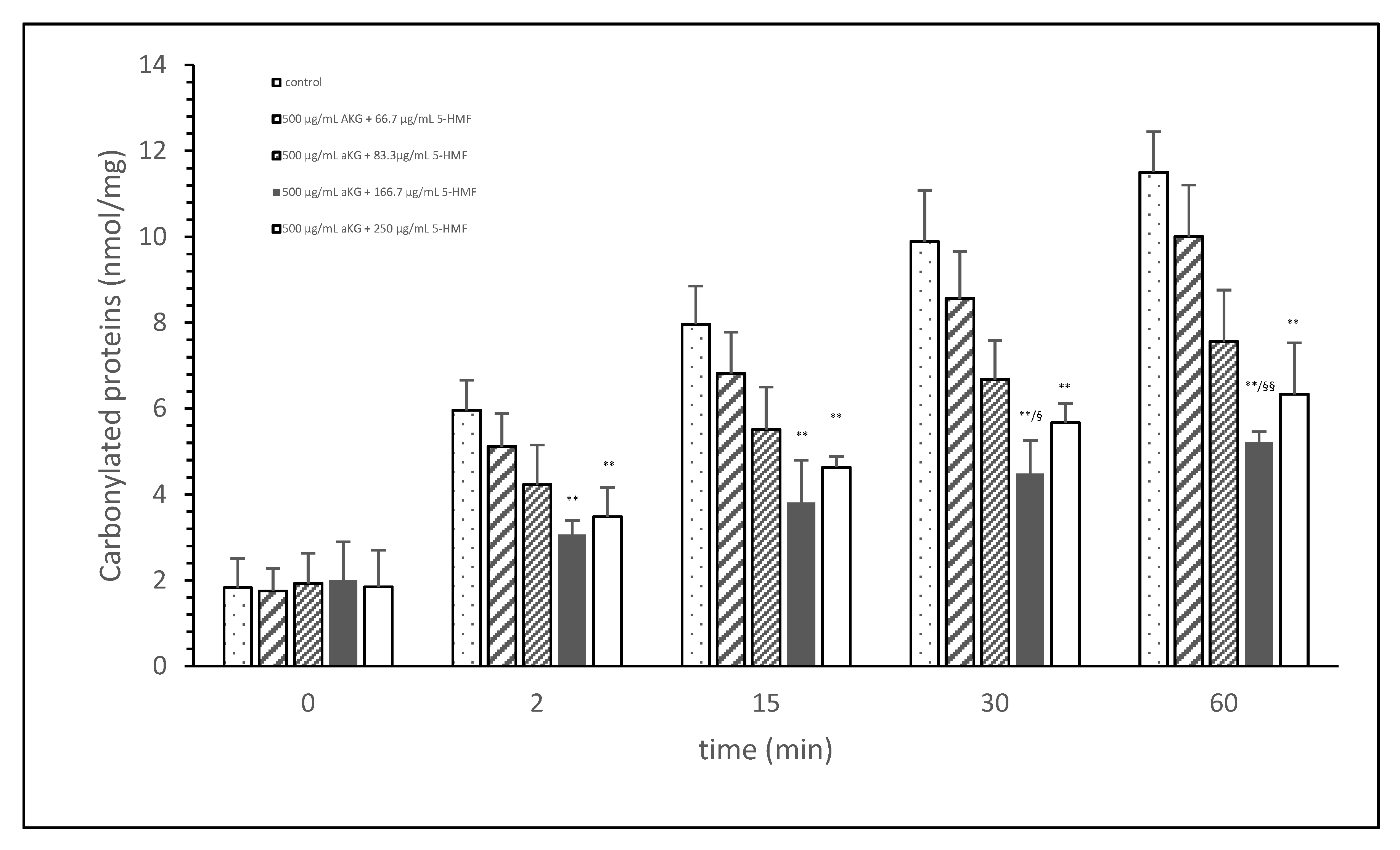
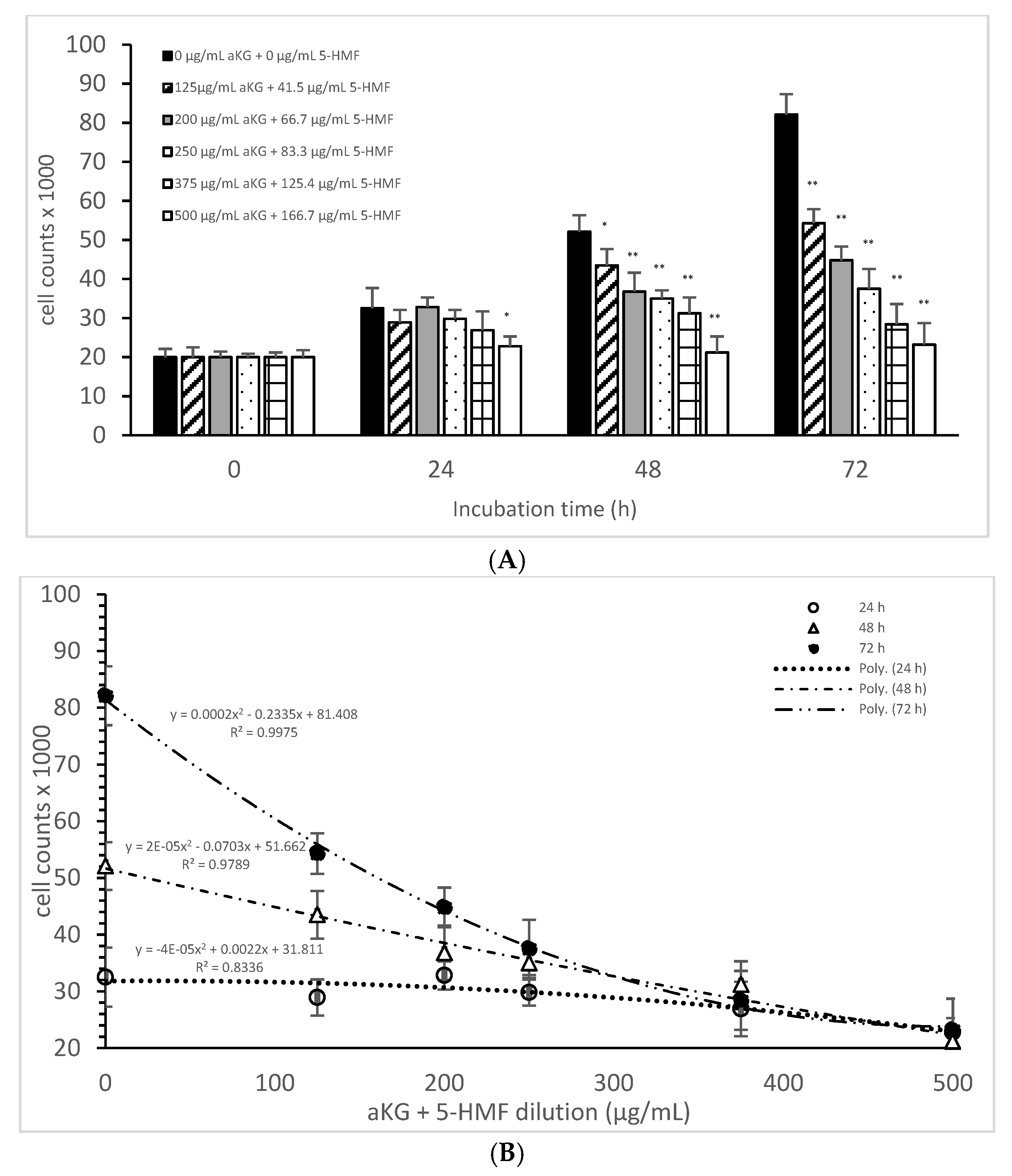
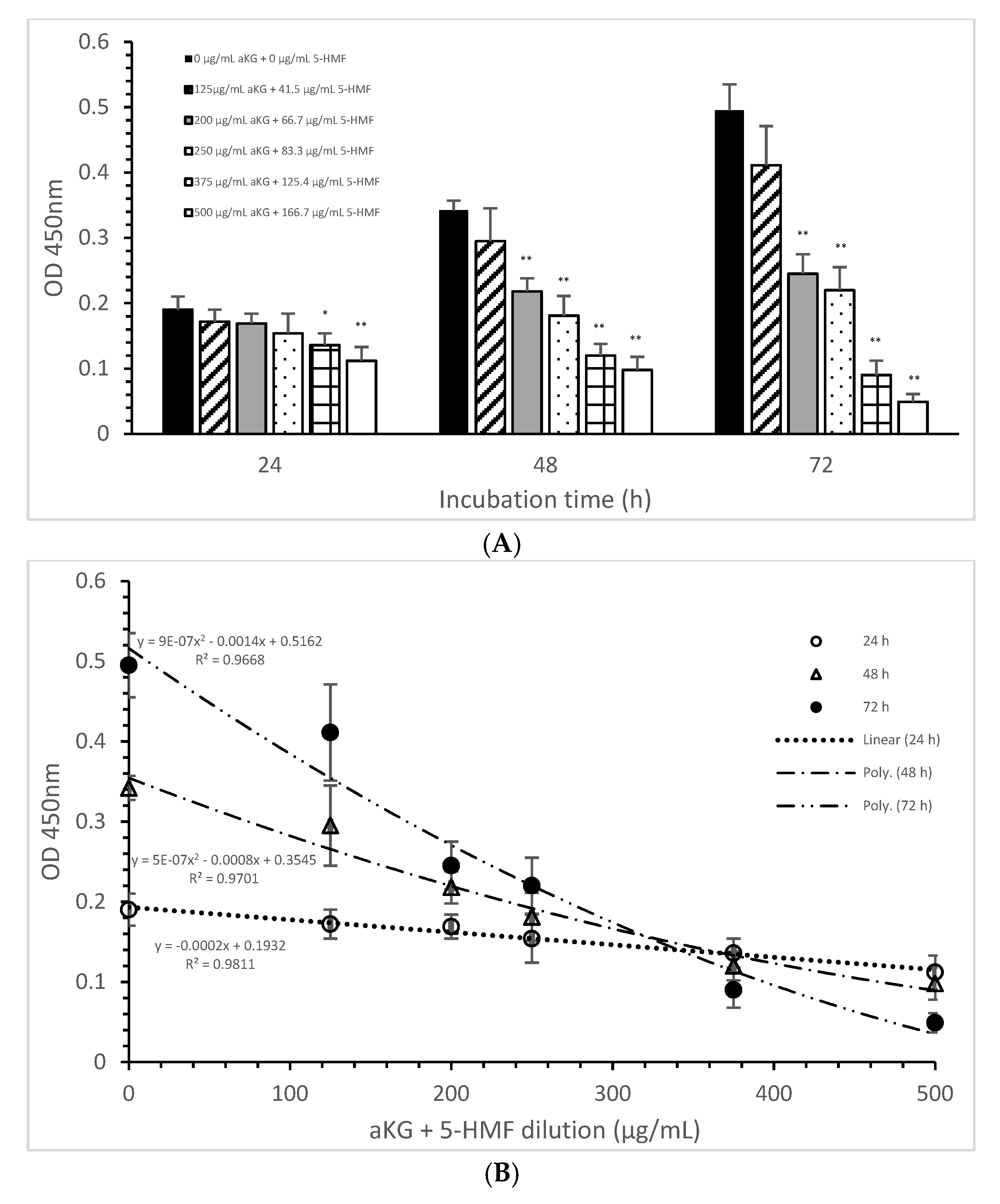
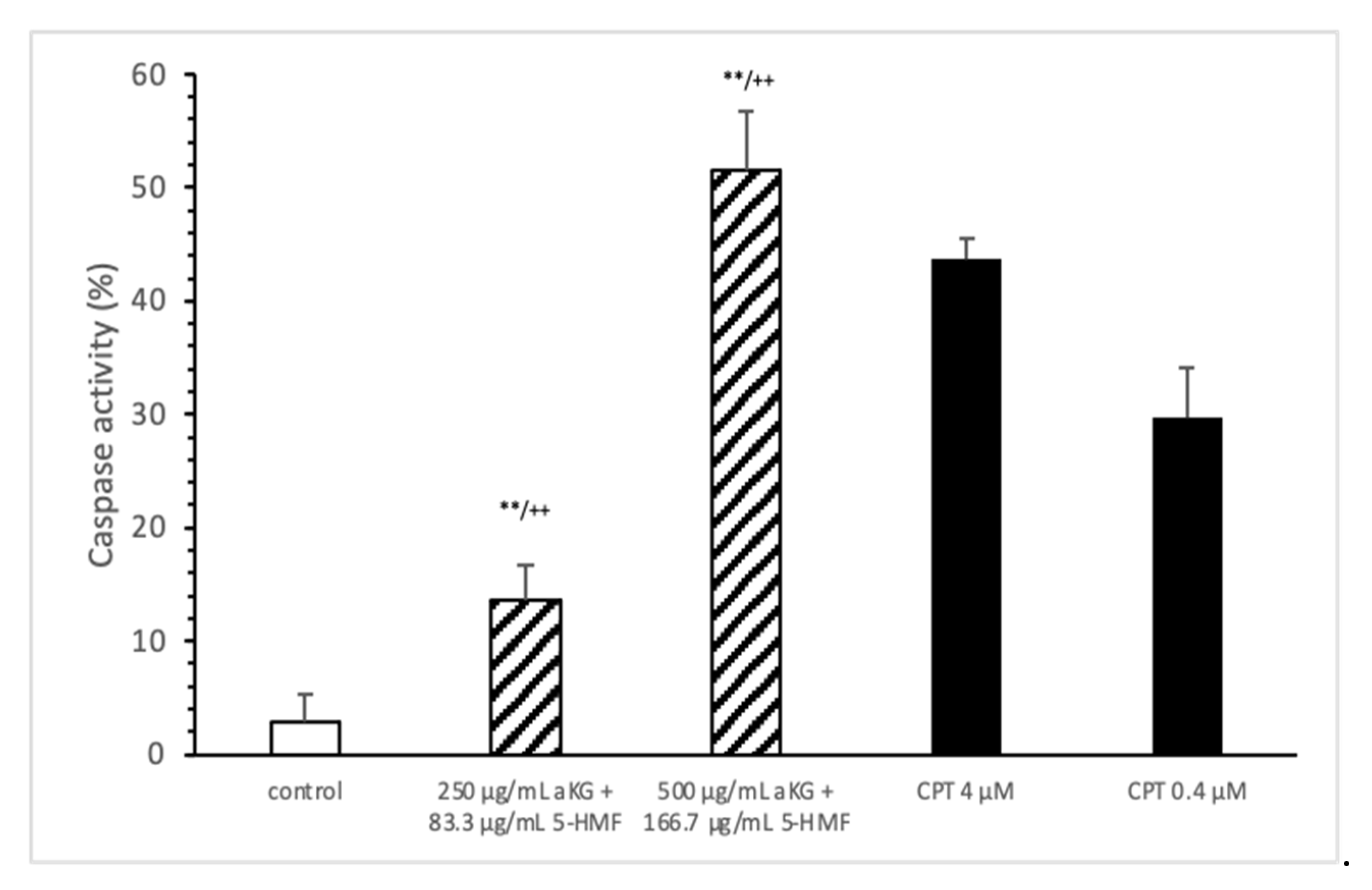
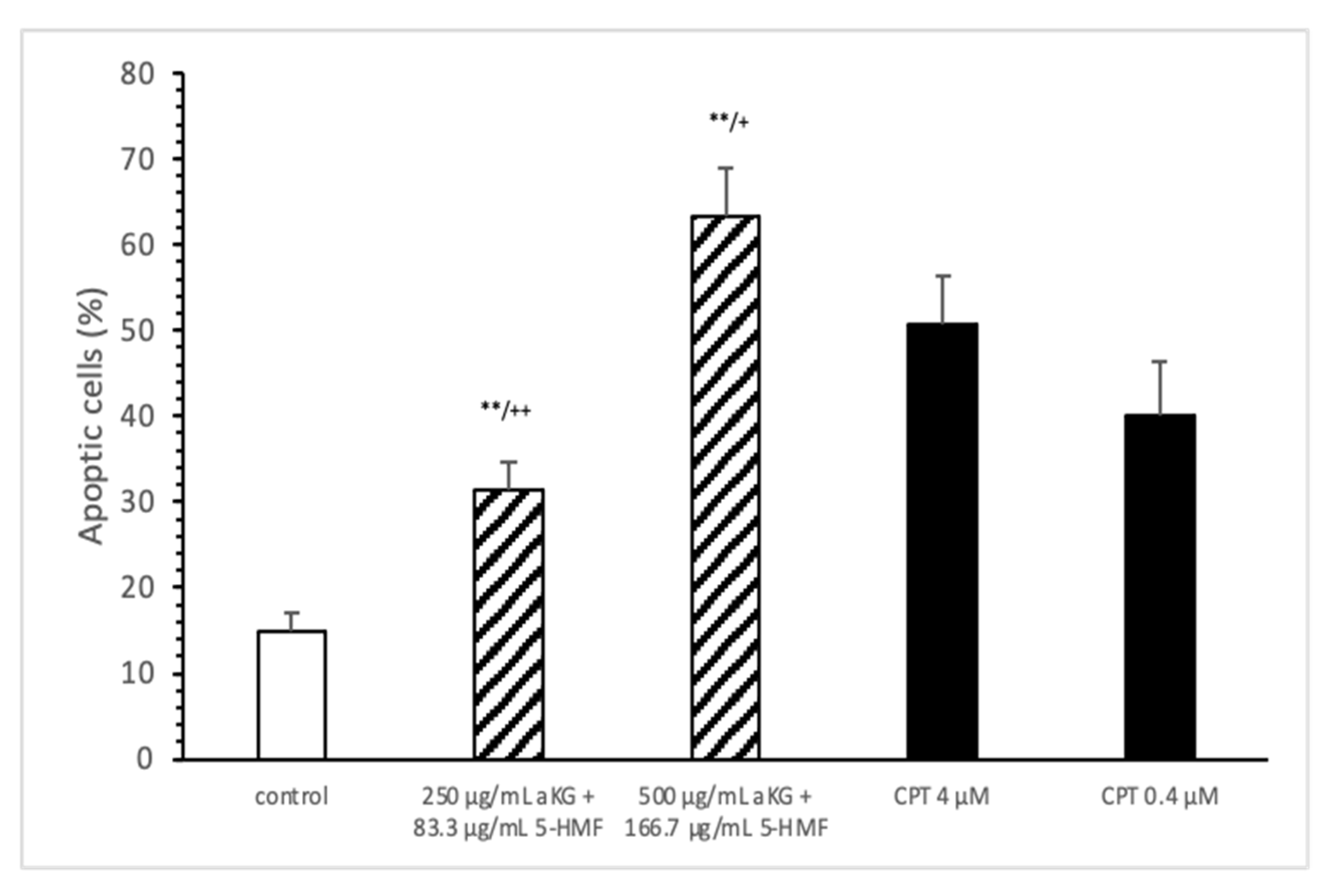
| Jurkat | 0 h | 24 h | 48 h | 72 h |
|---|---|---|---|---|
| Cell growth | % | % | % | % |
| 0 µg/mL aKG + 0 µg/mL 5-HMF | 100 ± 7.5 | 190.5 ± 13.6 | 286.0 ± 2.1 | 376.5 ± 5.0 |
| 125 µg/mL aKG + 41.7 µg/mL HMF | 105 ± 3.5 | 150.5 ± 14.0 | 266.0 ± 6.0 | 331.0 ± 6.3 |
| 200 µg/mL aKG + 66.7 µg/mL 5-HMF | 101 ± 2.5 | 168.1 ± 20.2 | 216.7 ± 5.8 | 304.5 ± 5.9 |
| 250 µg/mL aKG + 83.3 µg/mL 5-HMF | 103 ± 9 | 165.5 ± 6.3 | 206.4 ± 7.8 | 290.5 ± 8.8 |
| 375 µg/mL aKG + 125 µg/mL 5-HMF | 98.7 ± 5.5 | 179.0 ± 8.7 | 195.5 ± 4.6 | 296.5 ± 7.1 |
| 500 µg/mL aKG + 166.7 µg/mL 5-HMF | 105 ± 3.5 | 165.5 ± 7.6 | 222.5 ± 3.4 | 256.0 ± 9.6 |
| HF-SAR | 0 h | 24 h | 48 h | 72 h |
| Cell growth | % | % | % | % |
| 0 µg/mL aKG + 0 µg/mL 5-HMF | 101.3 ± 7.5 | 88.7 ± 9.9 | 92.3 ± 12.1 | 126.6 ± 14.5 |
| 125 µg/mL aKG + 41.7 µg/mL HMF | 100.0 ± 3.1 | 85.0 ± 7.3 | 92.8 ± 9.2 | 121.7 ± 9.2 |
| 200 µg/mL aKG + 66.7 µg/mL 5-HMF | 104.1 ± 1.5 | 89.3 ± 8.9 | 100.6 ± 7.9 | 121.4 ± 13.1 |
| 250 µg/mL aKG + 83.3 µg/mL 5-HMF | 99.0 ± 6.1 | 82.7 ± 4.2 | 89.3 ± 4.1 | 137.6 ± 22.1 |
| 375 µg/mL aKG + 125 µg/mL 5-HMF | 99.9 ± 3.5 | 93.8 ± 11.0 | 104.3 ± 11.1 | 132.6 ± 29.1 |
| 500 µg/mL aKG + 166.7 µg/mL 5-HMF | 102.0 ± 3.1 | 86.2 ± 4.1 | 97.9 ± 8.2 | 140.5 * ± 23 |
| Jurkat | 24 h | 48 h | 72 h |
|---|---|---|---|
| Mitochondrial Activity | % | % | % |
| 0 µg/mL aKG + 0 µg/mL 5-HMF | 100 ± 10.5 | 100 ± 4.4 | 100 ± 8.1 |
| 125 µg/mL aKG + 41.7 µg/mL HMF | 90.5 ± 9.5 | 86.3 ± 14.6 | 83 ± 12.1 |
| 200 µg/mL aKG + 66.7 µg/mL 5-HMF | 88.9 ± 7.9 | 63.7 ± 5.8 ++ | 49.5 ± 6.1 $$ |
| 250 µg/mL aKG + 83.3 µg/mL 5-HMF | 81.1 ± 15.8 | 52.9 ± 8.8 ++ | 44.4 ± 7.1 $$ |
| 375 µg/mL aKG + 125 µg/mL 5-HMF | 71.6 ± 9.5 * | 35.1 ± 5.3 ++ | 18.2 ± 4.4 $$ |
| 500 µg/mL aKG + 166.7 µg/mL 5-HMF | 58.9 ± 11.1 ** | 28.7 ± 5.8 ++ | 9.9 ± 2.4 $$ |
| HF-SAR | 24 h | 48 h | 72 h |
| Mitochondrial Activity | % | % | % |
| 0 µg/mL aKG + 0 µg/mL 5-HMF | 100 ± 11.4 | 100 ± 4.1 | 100 ± 8.4 |
| 125 µg/mL aKG + 41.7 µg/mL HMF | 86.7 ± 5.3 | 90.7.3 ± 5.2 | 83.1 ± 6.2 |
| 200 µg/mL aKG + 66.7 µg/mL 5-HMF | 90.7 ± 6.9 | 88.2 ± 8.3 | 91.1 ± 4.2 |
| 250 µg/mL aKG + 83.3 µg/mL 5-HMF | 84.3 ± 5.1 | 85.3 ± 6.8 | 91.9 ± 5.1 |
| 375 µg/mL aKG + 125 µg/mL 5-HMF | 90.0 ± 5.5 | 89.6 ± 6.1 | 95.8 ± 5.9 |
| 500 µg/mL aKG + 166.7 µg/mL 5-HMF | 90.8 ± 4.6.1 | 83.7 ± 11.3 | 99.1 ± 9.2 |
| Carbonylated Proteins (nmol/mg Protein) | ||||
|---|---|---|---|---|
| Jurkat Lysate | HF-SAR Lysate | |||
| 0 h | 72 h | 0 h | 72 h | |
| 250 µg/mL aKG + 83.3 µg/mL 5-HMF | 11.6 §§ ± 0.67 | 7.44 ± 0.93 ** | 2.10 ± 0.72 | 1.91 ± 0.82 |
| 500 µg/mL aKG + 166.7 µg/mL 5-HMF | 10.6 §§ ± 0.37 | 5.55 ± 1.22 ** | 2.5 ± 0.6 | 1.73 ± 0.52 * |
Publisher’s Note: MDPI stays neutral with regard to jurisdictional claims in published maps and institutional affiliations. |
© 2021 by the authors. Licensee MDPI, Basel, Switzerland. This article is an open access article distributed under the terms and conditions of the Creative Commons Attribution (CC BY) license (https://creativecommons.org/licenses/by/4.0/).
Share and Cite
Greilberger, J.; Herwig, R.; Greilberger, M.; Stiegler, P.; Wintersteiger, R. Alpha-Ketoglutarate and 5-HMF: A Potential Anti-Tumoral Combination against Leukemia Cells. Antioxidants 2021, 10, 1804. https://doi.org/10.3390/antiox10111804
Greilberger J, Herwig R, Greilberger M, Stiegler P, Wintersteiger R. Alpha-Ketoglutarate and 5-HMF: A Potential Anti-Tumoral Combination against Leukemia Cells. Antioxidants. 2021; 10(11):1804. https://doi.org/10.3390/antiox10111804
Chicago/Turabian StyleGreilberger, Joachim, Ralf Herwig, Michaela Greilberger, Philipp Stiegler, and Reinhold Wintersteiger. 2021. "Alpha-Ketoglutarate and 5-HMF: A Potential Anti-Tumoral Combination against Leukemia Cells" Antioxidants 10, no. 11: 1804. https://doi.org/10.3390/antiox10111804
APA StyleGreilberger, J., Herwig, R., Greilberger, M., Stiegler, P., & Wintersteiger, R. (2021). Alpha-Ketoglutarate and 5-HMF: A Potential Anti-Tumoral Combination against Leukemia Cells. Antioxidants, 10(11), 1804. https://doi.org/10.3390/antiox10111804






